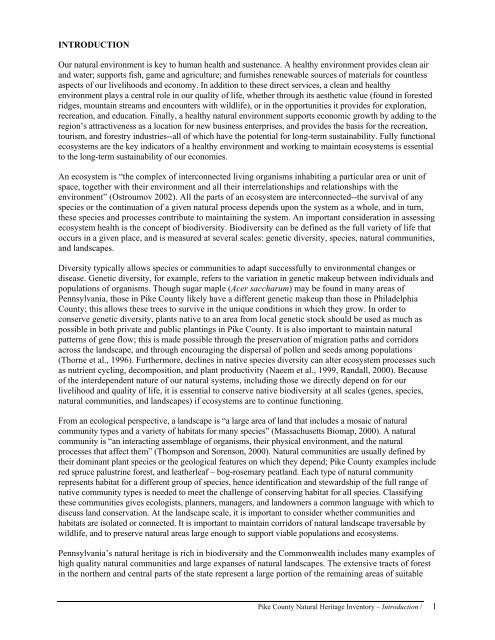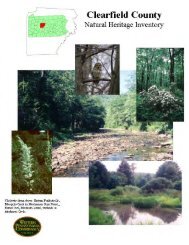Pike CNHI - Pennsylvania Natural Heritage Program
Pike CNHI - Pennsylvania Natural Heritage Program
Pike CNHI - Pennsylvania Natural Heritage Program
You also want an ePaper? Increase the reach of your titles
YUMPU automatically turns print PDFs into web optimized ePapers that Google loves.
INTRODUCTION<br />
Our natural environment is key to human health and sustenance. A healthy environment provides clean air<br />
and water; supports fish, game and agriculture; and furnishes renewable sources of materials for countless<br />
aspects of our livelihoods and economy. In addition to these direct services, a clean and healthy<br />
environment plays a central role in our quality of life, whether through its aesthetic value (found in forested<br />
ridges, mountain streams and encounters with wildlife), or in the opportunities it provides for exploration,<br />
recreation, and education. Finally, a healthy natural environment supports economic growth by adding to the<br />
region’s attractiveness as a location for new business enterprises, and provides the basis for the recreation,<br />
tourism, and forestry industries--all of which have the potential for long-term sustainability. Fully functional<br />
ecosystems are the key indicators of a healthy environment and working to maintain ecosystems is essential<br />
to the long-term sustainability of our economies.<br />
An ecosystem is “the complex of interconnected living organisms inhabiting a particular area or unit of<br />
space, together with their environment and all their interrelationships and relationships with the<br />
environment” (Ostroumov 2002). All the parts of an ecosystem are interconnected--the survival of any<br />
species or the continuation of a given natural process depends upon the system as a whole, and in turn,<br />
these species and processes contribute to maintaining the system. An important consideration in assessing<br />
ecosystem health is the concept of biodiversity. Biodiversity can be defined as the full variety of life that<br />
occurs in a given place, and is measured at several scales: genetic diversity, species, natural communities,<br />
and landscapes.<br />
Diversity typically allows species or communities to adapt successfully to environmental changes or<br />
disease. Genetic diversity, for example, refers to the variation in genetic makeup between individuals and<br />
populations of organisms. Though sugar maple (Acer saccharum) may be found in many areas of<br />
<strong>Pennsylvania</strong>, those in <strong>Pike</strong> County likely have a different genetic makeup than those in Philadelphia<br />
County; this allows these trees to survive in the unique conditions in which they grow. In order to<br />
conserve genetic diversity, plants native to an area from local genetic stock should be used as much as<br />
possible in both private and public plantings in <strong>Pike</strong> County. It is also important to maintain natural<br />
patterns of gene flow; this is made possible through the preservation of migration paths and corridors<br />
across the landscape, and through encouraging the dispersal of pollen and seeds among populations<br />
(Thorne et al., 1996). Furthermore, declines in native species diversity can alter ecosystem processes such<br />
as nutrient cycling, decomposition, and plant productivity (Naeem et al., 1999, Randall, 2000). Because<br />
of the interdependent nature of our natural systems, including those we directly depend on for our<br />
livelihood and quality of life, it is essential to conserve native biodiversity at all scales (genes, species,<br />
natural communities, and landscapes) if ecosystems are to continue functioning.<br />
From an ecological perspective, a landscape is “a large area of land that includes a mosaic of natural<br />
community types and a variety of habitats for many species” (Massachusetts Biomap, 2000). A natural<br />
community is “an interacting assemblage of organisms, their physical environment, and the natural<br />
processes that affect them” (Thompson and Sorenson, 2000). <strong>Natural</strong> communities are usually defined by<br />
their dominant plant species or the geological features on which they depend; <strong>Pike</strong> County examples include<br />
red spruce palustrine forest, and leatherleaf – bog-rosemary peatland. Each type of natural community<br />
represents habitat for a different group of species, hence identification and stewardship of the full range of<br />
native community types is needed to meet the challenge of conserving habitat for all species. Classifying<br />
these communities gives ecologists, planners, managers, and landowners a common language with which to<br />
discuss land conservation. At the landscape scale, it is important to consider whether communities and<br />
habitats are isolated or connected. It is important to maintain corridors of natural landscape traversable by<br />
wildlife, and to preserve natural areas large enough to support viable populations and ecosystems.<br />
<strong>Pennsylvania</strong>’s natural heritage is rich in biodiversity and the Commonwealth includes many examples of<br />
high quality natural communities and large expanses of natural landscapes. The extensive tracts of forest<br />
in the northern and central parts of the state represent a large portion of the remaining areas of suitable<br />
<strong>Pike</strong> County <strong>Natural</strong> <strong>Heritage</strong> Inventory – Introduction / 1










